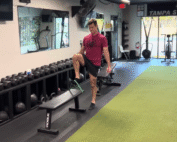Not Just About Balance: The importance of single leg training
Being able to balance on one leg is incredibly important for healthy movement for life. A good majority of all activities us humans do involve being on one leg. It is something that well…makes us human! James Earls’ book Born to Walk explains it in more detail.

Despite what your exercise and fitness goals are, a healthy training regimen should include single leg exercises. Athletes and soccer moms alike can benefit from single leg training.
Single leg training can help you get stronger than training on two legs by a phenomenon called bilateral limb deficit or BLD. This can better be explained by well known strength coach Mike Boyle.
“BLD is the difference in maximal or near maximal force generating capacity of muscles when they are contracted along or in combination with the contralateral muscles…” (Mike Boyle, strength coach)
This means that the sum of each leg (unilateral) is stronger than both legs (bilateral). With this logic you can get stronger by training each leg at a time rather than two.
This is especially important for athletes, who for a majority spend a lot of time on 1-leg. Single leg performance affects almost every sport, even sports that you might not think of like golf.
“In order to swing the club effectively, each leg has to support a large portion of your body weight on its own… When professional golfers take the club back, roughly 80 percent of their body weight is supported by their back leg. And when they transition from backswing to downswing, the left leg takes 80 to 90 percent of the load. This weight shift is key to creating, storing and then transferring energy from your body into the club and eventually the ball.” (Ron Kapriske)
Similar to other aspects of training there are an endless amounts of regressions and progression to single leg training. Single leg training can also be quite dynamic in the ability to combine upper and lower body movements with a variety of training tools.
An easy place to start can be as simple as balancing on 1-leg for 10-20 seconds. Single leg training can be used for plyometrics, strength, balance, mobility, speed, agility, quickness, and even core training. Some example of exercises are: split squats, lunges (in all directions and variations), single leg RDL’s, single leg box jumps, single leg hurdle hops, step ups, single leg bounds, and many more.
If you are new to single leg training make sure to not progress too quickly. This can lead to faulty movement patterns or even worse, injury!
Thanks for taking the time to read this article! If you’re interested in seeing what single leg training can do for your performance, contact us or find us on social media!
IG: @tampastrength
Twitter: @tampastrength
Facebook: facebook.com/TampaStrengthAcademy
Email: john@tampastrength.com
Phone: 813-731-2901
Resources
- Earls, James. “Chapter 2 The Mechanical Chain.” Born to Walk: Myofascial Efficiency and the Body in Movement. Nutbourne, Chichester: Lotus, 2014. 50. Print.
- Boyle, Michael. “Chapter 6: Lower Body Training.” New Functional Training for Sports. Champaign, IL: Human Kinetics, 2016. N. pag. Print
- Kaspriske, Ron. “The Importance of Single-leg Exercise for Golf.” Golf Digest. N.p., 20 July 2015. Web. 28 Mar. 2017.







